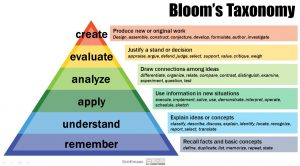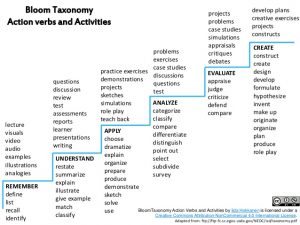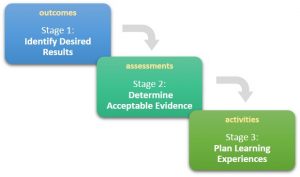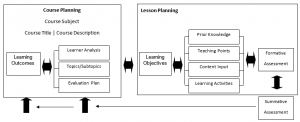Course Learning Outcomes (CLOs) are central to your course’s curriculum. They articulate to students, faculty, and other stakeholders what students will achieve in each course and how their learning will be measured. A learning outcome is a measurable, observable, and specific statement that clearly indicates what a student should know and be able to do at the end of the course. They answer the question – “What should the student be able to demonstrate by the end of this course?”.
Writing or Revising Course Learning Outcomes
Writing robust learning outcomes can be a challenging task but once accomplished they provide a solid foundation for designing the curriculum for your course.
Principles of Good Course Learning Outcomes
- Clear
- Measurable
- Performance based and observable – prepare, calculate, identify, describe, discuss. compare, create, evaluate, etc.
- Avoid verbs: know, understand, comprehend, appreciate, realize, study, be familiar with etc. (they’re too vague and cannot be measured)
- Include performance – action verb, context/topic – describes what they will do, and criterion/standard – describes what is an acceptable performance
- Represent integration of learning
- Authentic to what the real application would look like
- Aim for 5-7 per course (for 42hr course)
- Align with a course description
- Align with Program Learning Outcomes or General Education Themes
- Describe learning that is fully evaluated by the end of the course
Bloom’s Taxonomy
Using a taxonomy that explains different levels of learning can be helpful for selecting the appropriate action verbs for your course learning outcomes. These will help prevent you from choosing lower-order actions when you really want students to demonstrate higher-order thinking. 
Bloom’s Taxonomy is broken into six knowledge dimensions: Remembering, Understanding, Applying, Analyzing, Evaluating, and Creating and range from lower-order thinking skills to higher-order thinking skills.
By their very nature, higher-order thinking skills are more difficult and build on the previous lower-order thinking skills. An oversimplified explanation of this would be the following: A student can not be expected to create a design brief (Creating) if they can’t remember what a design brief is (Remembering).
Traditionally, entry-level courses ask students to demonstrate remembering, understanding and applying thinking skills with a few higher-order thinking skills while years 2, 3 and post-graduate level courses ask students to demonstrate analyzing, evaluating, and creating thinking skills with a few lower-order thinking skills.
Steps to Writing Course Learning Outcomes:
Step 1: Select an action verb using Bloom’s Taxonomy

The illustration demonstrates, in a staircase style, the teaching strategies related to the action verbs that go into which section in Bloom’s Taxonomy. This is not an exhaustive list, but it does provide examples of specific action verbs that link to different levels of student learning.
Step 2: Select the context or reason that expands on the purpose or adds clarity to the learning.
Step 3: Next, decide if your course learning outcome requires either a criteria or standard. This does not appear in every CLO but when it does, it suggests to what level the performance must be accomplished.
Sample CLOs that apply the three components – Performance (Action Verb), Context, Criterion/Standard. The components do not have to appear in that order.
Perform a comprehensive physical assessment of body systems in a systemic, accurate and effective manner.
Apply theoretical concepts of growth and development when working with individuals and families in the community.
Complete a variety of accounting transactions using the double-entry accounting system.
Modify a recreation or fitness activity that adheres to accepted design principles in adaptive recreation settings.
Sample CLO without a criterion/standard
Explain terms and processes relevant to waste-site remediation and restoration.
When writing your course learning outcomes, keep in mind…
Learning outcomes should be SMART(TT)
| Speak to the Learner |
Learning outcomes should address what the learner will know or be able to do at the completion of the course |
| Measurable |
Learning outcomes must indicate how learning will be assessed |
| Applicable |
Learning outcomes should emphasize ways in which the learner is likely to use the knowledge or skills gained |
| Realistic |
All learners who complete the activity or course satisfactorily should be able to demonstrate the knowledge or skills addressed in the outcome |
| Time-bound |
The learning outcome should set a deadline by which the knowledge or skills should be acquired |
| Transparent |
Should be easily understood by the learner |
| Transferable |
Should address knowledge and skills that will be used by the learner in a wide variety of contexts |
The SMART(TT) method of goal setting is adapted from Blanchard, K., & Johnson, S. (1981). The one minute manager. New York: Harper Collins.
 The backward design process occurs in three phases:
The backward design process occurs in three phases:


